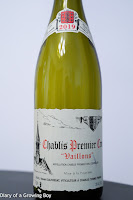Pin It
Besides getting his fill of decent Chinese food while he's in town, the Compatriot also wanted to have some more Japanese food before going back to Rosbif Land. He did visit a few sushiya while in Taipei, but it will be a while before he gets decent sushi again. So I found a way to get us seats for an early seating at Sushi Fujimoto (鮨ふじもと).
The "no picture policy" on any food items that is not tuna remains in place, so this would be another "no picture day" for me. It's kinda annoying, but for my friend's sake I guess I would just suck it up...
Once again, we started our meal with some abalone, the first part of which was a small cup of abalone broth that was nice and complex, with some umami (旨味) thanks to kombu.
The abalone (鮑) today came from Chiba (千葉), and was steamed for 6 hours. Once again the thin, large slice was taken "as is" without any condiment. The flavors here were outstanding and very 鮮. A little dab of wasabi was applied to the thicker cut, and dipped into the abalone liver sauce on the side.
The final part involved a ball of shari (シャリ) placed on the dish with the abalone liver sauce. Unfortunately my ball of rice fell apart as I tried to pick it up with my chopsticks. May I suggest that we get little spoons for this purpose?
Next came a small bowl with some Japanese horsehair crab (毛蟹) from Hokkaido, topped with a small dab of crab tomalley (蟹味噌) and served with thickened ankake (餡掛け) made with ichibandashi (一番出汁).
Japanese hairtail (大刀魚) - from Koshiba (小柴) in Kanagawa (神奈川). Steamed with sake on kombu, served with a little ponzu (ポン酢), and topped with shredded leeks.
Rosy seabass (喉黒) - our substitute for fatty tuna collar (カマトロ). From Nagasaki (長崎) and aged for 1 week. Lightly cooked by contact with charcoal on the skin, which resulted in some smoky flavors. This was very, very tender but still slightly crunchy just underneath the skin.
The appearance of pieces of scorched rice (お焦げ) signaled the impending start of the nigirizushi (握り寿司) portion of our meal.
I noticed that the pickled ginger (ガリ) was placed on the left hand side of Sankala's board. So they were pretty observant, then...
Yellowtail (鰤) - from Hokkaido. Weighing around 10kg, and still pretty crunchy. Good acidity in the shari.
Japanese bluefish (黒睦) - our substitute for lean tuna (赤身). Scored on top and torched, so it was smoky and a little bitter. This was aged very nicely so the texture was a little bit mushy.
Gizzard shad (小鰭) - the size was between 新子 and adult, so Fujimoto-san jokingly called this "teenager". Good acidity balance in the neta (ネタ) marinade.
Japanese glass shrimp (白海老) - our substitute for medium fatty tuna (中トロ).
Sardine (鰯) - our substitute for fatty tuna (大トロ). Sooo fatty, sooo good, soooo tasty.
Pink sea urchin (赤雲丹) - our other substitute for fatty tuna (大トロ). Special premium grade (特上) sourced from Kawakatsu (川勝) in Yura (由良) on Awaji Island (淡路島). Really sweet.
Swordtip squid (白烏賊) - from Aomori (青森). Scored many times to create many "strands", which ultimately became soft and tender. With a touch of sudachi (酢橘) juice on top.
We were then served the tentacles of the swordtip squid, lightly grilled.
Horse mackerel (鯵) - from Kagoshima (鹿児島). Very tender as expected, with a dab of asatsuki (浅葱) on top that was so fragrant and tasty.
Bering Sea cockles (石垣貝) - from Iwate (岩手). There's a nice contrast between the cold neta and the warm shari here. The neta was very sweet, and mostly tender but still delivered some crunch.
Japanese tiger prawn (車海老) - the taste of tomalley was pretty prominent.
Salmon roe (イクラ) - in a gunkanmaki (軍艦巻き) with some yuzu (柚子).
Purple sea urchin (紫雲丹) - sourced from Kaneshin Seafood (カネシン水産) in Sapporo. Texture was a little firm, and I tasted a little more iodine.
Eel hand roll (鰻手巻き) - once again we have the grilled local 白鱔, which was very springy and very nice, with tasty collagen.
A nice little cup of soup came next. The spring onions were very tasty.
Kanpyo roll (干瓢巻き) - nice with some fragrance of yuzu.
Finally, two types of egg custard (玉子焼き) - the "regular" and the one with Okinawan muscovado (黒糖).
We brought along a few bottles to help make this a happy meal.
Yoshinogawa Shinko-gura Daiginjo Genshu Koshitanrei 10YO (吉乃川 眞浩蔵 大吟醸原酒 越淡麗10年貯蔵), H19BY - seimaibuai of 40%. Lovely fermented nose, very savory 30 minutes after opening. Nice and complex. After 2 hours this was very soft on the palate and sweet. Drinking beautifully.
2019 Dauvissat Chablis 1er Cru Vaillons - nice nose of lemon and flint, lean on the nose. The acidity was on the high side but still ripe and alcoholic on the palate.
1992 Moët et Chandon Cuvée Dom Pérignon - pretty obviously corked, with very big green nose of grass, wet cardboard, on top of straw, sugar cane, and Chinese licorice.
I think the Compatriot was pretty happy, as this may be the last good sushi meal for him for a while. Our eating adventure together continues tomorrow...




No comments:
Post a Comment